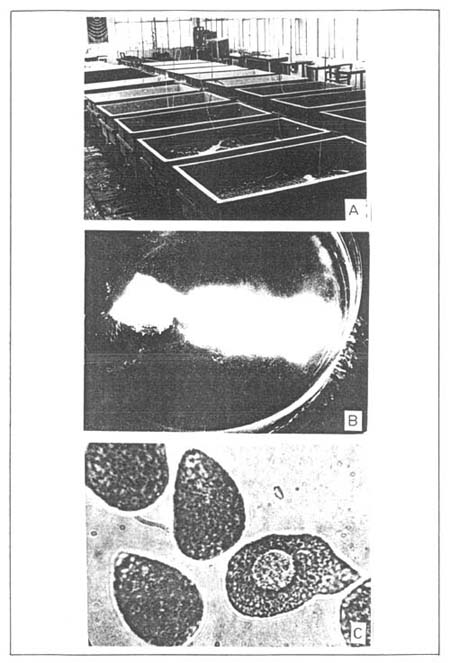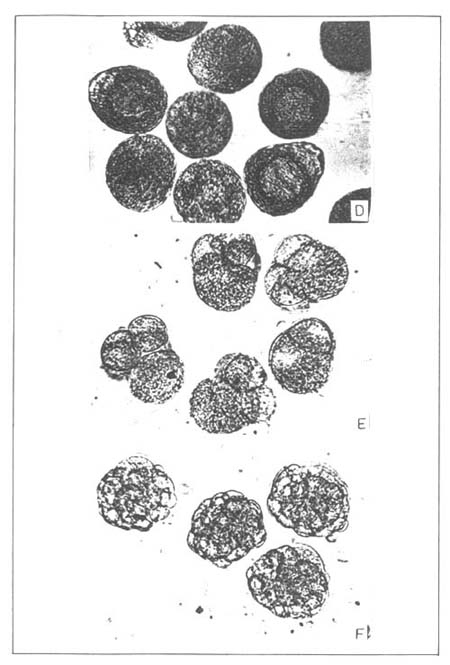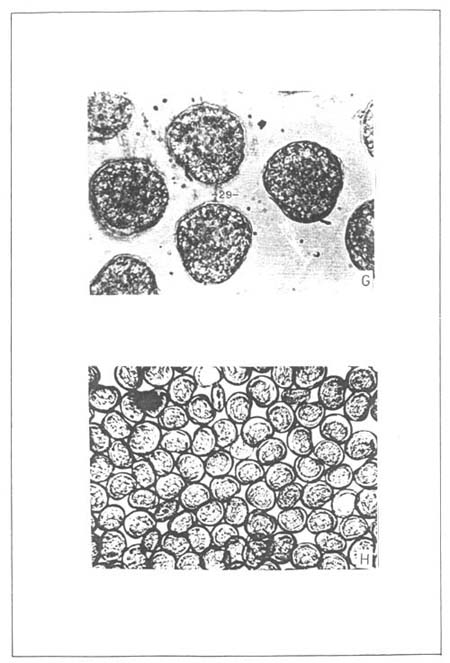Seed of P. fucata, were produced in 1981 in the laboratory through hatchery techniques at the Central Marine Fisheries Research Institute at Tuticorin. The technology developed is helpful in overcoming the problem of insufficient supply of mother oysters for cultured pearl production. The hatchery methods developed are simple to adopt and inexpensive. The suitability of the technology has been proved by producing seed during most of the year. The hatchery is one of the most important sources of sustained supply of pearl oysters.
The pearl oyster hatchery of the CMFRI at Tuticorin has facilities for oyster conditioning, maturation and spawning, as well as larval and spat rearing (Plate II A). The roof of the hatchery building is sufficiently high to avoid high temperature. Part of the roof of the wet laboratory has translucent fibreglass sheets to allow sufficient light for indoor phytoplankton culture. Glass panelled large windows and ventilators are provided for free passage of light and air. The concrete floor has sufficient gradient facilities for easy drainage.
The seawater is usually drawn from the sea beyond the low water mark into a well through PVC pipes. The seawater is pumped to sedimentation tanks and passed onto the biological filter which contains coarse river sand at the top, pebbles below it and charcoal at the bottom. The filtered seawater is stored in a water sump and lifted to an overhead tank for supply to the hatchery. Periodic cleaning of the filter bed keeps the seawater uncontaminated. PVC, fibreglass and stainless steel materials are used in the hatchery. The seawater sterilized by ultraviolet irradiation is used only in specific cases.
Air compressors with storage tank are used to aerate seawater in the rearing tanks. The compressed air is passed through a series of filters to remove oil and moisture and is supplied to the various culture vessels through PVC pipes. Air is drawn at the required places from these pipes running the entire length of the hatchery through nozzles. The air is supplied to the tanks through diffuser stones.
Flagellates measuring less than 10 μm form the main food for pearl oyster larvae. Isochrysis galbana is an important algal food for the larvae. Other microalgal cells such as Pavlova, Chromulina and Dicrateria are also suitable for the larvae. The growth and spatfall timing varies with the different algal foods. Chromulina promotes faster growth while Dicrateria gives better spatfall.
The flagellates are grown in 4-1 Haufkin flasks as stock culture and in 20-1 glass carbuoys and 100-1 perspex tanks in mass culture. Conway or Walne's medium is used for the culture of these flagellates. They enter the stationery phase of growth in about 15 days in Haufkin flasks and are maintained for two months without aeration. In mass culture, the maximum cell concentration is reached within 5–6 days. The composition of the medium used for mass culture as well as mixed algal culture is as follows:
| Potassium nitrate | : | 0.4 g |
| Potassium dihydrogen | ||
| Orthophosphate | : | 0.2 g |
| Sodium silicate | : | 0.2 g |
| Sodium EDTA | : | 0.2 g |
| Filtered seawater | : | 30.0 l |
Oyster broodstock are maintained at a water temperature ranging from 25–28 °C in a controlled room. They are fed with a mixed algal diet at a ration of 4 l per oyster/day. The algal food is supplemented by raw corn flour at 30 mg per oyster/day. Pearl oysters with maturing gonad fed with the above food for 45 days will spawn with a 30 % response. The matured oysters can be kept for a prolonged period at 25–28 °C, while spawning of these oysters can be stimulated by raising the water temperature by few degrees.
Spawning of natural oysters with mature gonads occurs when there is a simple change in the seawater environment or a mechanical shock by shell cleaning or a change in water pressure. In all cases males spawn first (Plate II B) and this induces the females to spawn within 30 minutes.
In the absence of natural spawning the technique of induce spawning is employed. In this technique thermal stimulation is adopted predominantly by gradually increasing the water temperature by several degrees (from 28.5 °C to 35.0 °C). Spawning of pearl oysters can also be effected by chemical stimulation. Different concentrations (1.532, 3.064 and 6.128 millimolars) of hydrogen peroxide in combination either with normal seawater or alkaline seawater (pH 9.1) is used in inducing spawning. Different pH media (8.5, 9.0, 9.5 and 10.0) are prepared either using Tris buffer or Sodium hydroxide pellets (NaOH) and the pearl oysters are induced to spawn. A pH value of 9.0 in the case of Tris buffer and 9.5 in NaOH gives 78.6 % and 68.4 % of spawning, respectively. Injection of 0.2 ml of N/10 ammonium hydroxide (NH4OH) solution into the adductor muscle of the pearl oyster results in 48 % spawning.
When the eggs are released in the medium, they are pyriform in shape measuring 73.9 μm along the long axis and 45.2 μm in width. The yolk cytoplasm is heavily granulated and opaque. The egg is enclosed in a vitelline membrane and a large germinal vesicle is seen at the centre (Plate II C).
Fertilization takes place externally in the water medium. Following fertilization, the pyriform eggs assume a spherical shape with the breakdown of the germinal vesicle (Plate II D). During fertilization the polar body appears and persists on the embryo up to blastula stage.
Cleavage
The first cell division is seen 45 minutes after fertilization resulting in the formation of a micromere and a macromere. The polar body is placed at the cleavage furrow (Plate II E). During the second cleavage the micromere divides into two and the macromere divides unequally into a micromere and macromere. The stage with three micromeres and a macromere is called Trefoil stage. The macromere does not take part in further divisions. Micromeres divide repeatedly thus becoming smaller and smaller and passing through 8-cell, 16-cell, and so on until the morula stage (Plate II F). Each micromere develops a small cilium which helps in the movement of the embryo.

PLATE II. (A) Inside view of the C. M. F. R. I. pearl oyster hatchery in Tuticorin, (B) Male oyster while spawning and (C) Pyriform oocytes.
Blastula
The embryo is ball-like with transparent cells and a blastocoel. The embryos lift themselves in the water column and congregate at the surface. The floating embryos are siphoned out to clean containers and the residues at the bottom, containing broken tissues, undeveloped embroys, unfertilized eggs, sperm, etc. are discarded. Reorientation of cells starts and the blastocoel and blastopore are formed. The blastula stage is reached 5 hours after fertilization.
Gastrula
Gastrulation takes place by epiboly. The cells convolute and differentiate into different dermal layers. The archenteron is formed. The embryo is bean-shaped as there is convolution of cells. The gastrula exhibits negative photrophism. This stage is reached in 7 hours.
Trochophore larva
The minute cilia present in the gastrula stage disappear and the pre-oral and post-oral tufts of cilia develop, thus marking antero-posterior differentiation of the embryo. A single apical flagellum is developed at the anterior side. The anterior portion of the larva is broader while the posterior end is tapering like an inverted triangle. The movement of the larva is affected by the propulsive movement of the flagellum (Plate II G). The dorsal ectodermal cells secrete the embryonic shell, known as the prodissoconch I.
Veliger
A definite ‘D’ shape is obtained by the secretion of the prodissoconch I having a hinge line, mantle and rearrangement of the pre-oral tuft of cilia into a velum. The single flagellum, pre-oral and post-oral tufts of cilia disappear. The veliger larva measures 67.5 μm along the antero-posterior axis and 52.5 μm along the dorso-ventral axis (Plate II H). This stage is reached in 20 hours.

PLATE II. Cont'd. (D) Fertilized oocytes, (E) Early cleavage and (F) Morula stage.

PLATE II. Cont'd. (G) Trochophore larvae and (H) Straight-hinge larvae.
Umbo stage
Further development of the veliger to the umbo stage is gradual with the development of the shell, prodissoconch II. The typical clam shaped umbo stage is reached between 10–12 days and it measures 135 × 130 μm (Plate III A). The shell valves are equal and the mantle folds are prominent.
Eye spot stage
After attaining the full umbo stage, the larvae develop an eye spot at the base of the foot primordium. A well developed velum effects the movement of the larvae. The ctenidial ridges develop at this stage. The minimum size at which the larva develops the eye spot is 180 x 170 μm (Plate III B) usually in 15 days.
Pediveliger stage
The foot is developed on the 18th day when the larvae measures 200 × 190 μm. The transitional stage from the swimming to the crawling phase has both velum and foot (Plate III C). Later the foot becomes functional while the velum disappears. Gill filaments are now visible (Plate III D).
Plantigrade
When the pediveliger larva selects a substratum for settlement, additional shell growth is seen along the globular shell margin except at the vertex of the umbo region, in the form of a very thin, transparent, uniform conchiolin film. In the meantime the byssal gland secretes byssal threads for attachment. Labial palps and gill filaments develop. The stage is reached in 20 days at the size of 220 × 200 μm (Plate III E).
Spat
By the repeated addition of dissoconch, the plantigrade transforms into a spat. It resembles an adult with the hinge line, anterior and posterior auricles and the byssal notch (Plate III F). The left valve is slightly more convex than the right one. The spat attaches itself to the substratum with the aid of the byssal threads. A healthy spat measures 300 μm in 24 days. The sizes and days given for the different larval and post-larval stages vary from batch to batch according to the environmental conditions.

PLATE III. (A) Umbo larvae, (B) Eye-spot larvae and (C) Transitional stage.

PLATE III. Cont'd. (D) Pediveliger larvae, (E) Plantigrade larvae and (F) spat.
Larval density plays a significant role in the growth of
pearl oyster larvae. Under identical conditions the larvae
show differential growth rate at different larval
densities. At higher densities the growth and spatfall are
poor. A culture density of two larvae per ml produces
optimum growth and spatfall rates.
The colour of the culture tanks also influences the setting
of larvae. Spatfall is much higher in FRP black tanks than
white and blue tanks.
Aeration during larval rearing affects growth and spatfall.
The effect of aeration is more pronounced in smaller
volumes of water. However, aeration is required after the
setting of the pearl oyster larvae.
Spat production is carried out in the molluscan hatchery at Tuticorin throughout the entire year. However, during May-August the spatfall is less due to high salinity, dustfall and warm landward wind. Sudden spurt of ciliates in the culture medium is common during this period. Such problems can be overcome by good management.
The microalgal cell Isochrysis galbana is provided to the larva from the veliger stage onwards. The optimum ration for a larvae is 5,000 cells/day up to umbo stage. The dose is doubled from the umbo to the pediveliger stage and tripled afterwards up to settlement. For about 15 days after settlement each spat is fed with I. galbana at 50,000 cells/day. Mixed algal diet containing mostly Chaetoceros and I. galbana is given in a ratio of 1:1 in the following 15 days. Later the spat is supplied with a mixed algal diet.
The spat are reared in the hatchery for about two months. By then they shall have grown to 3 mm or more. They are then transferred to the farm in velon screen netcages with a mesh size of 400 μm. Mortality may occur if spat measuring less than 3 mm are transplanted. Spat growth is monitored carefully and the netcages are changed whenever necessary. The size of mesh of the rearing cages is also monitored. The oyster spat attain an average size of 40–45 mm in 12 months.
In the hatchery about 20 % production of spat is achieved in tanks of 500-1 capacity and 40–50 % production in 50-1 tanks. The survival of transplanted spat in the farm is about 30 % at the end of one year.